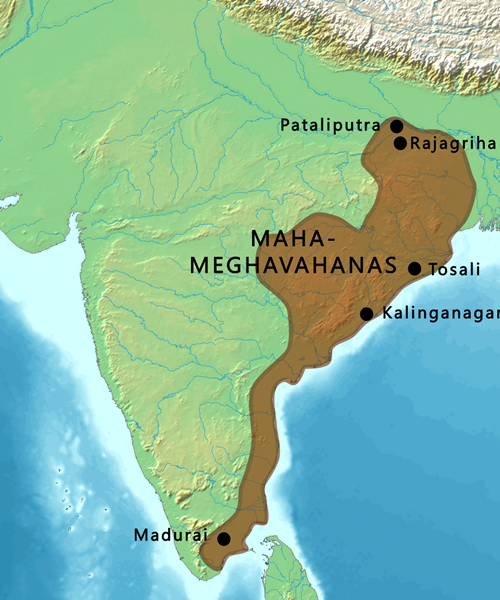Mahaveer Sanglikar
Emperor Kharvel, the ruler of Kaling (modern Odisha), is one of the most fascinating figures in Indian history. Despite limited historical records, his rock-cut Hathigumpha Inscription at the Udayagiri Caves provides invaluable insights into his reign and accomplishments.
Ruled from 193 to 180 BCE, Kharvel is celebrated for his military conquests, cultural patronage, administrative reforms, and devotion to Jainism.
Early Life and Ascension of Emperor Kharvel
The Hathigumpha Inscription at Udaygiri Hills near Bhuvaneshwar in Odisa states that Kharvel spent the first 24 years of his life mastering subjects like writing, coinage, administration, law, and sports. At 16, he was declared Yuvaraja (Crown Prince), and at 24, he ascended the throne of Kaling. A deep focus on governance, learning, and military strategy marked his early years.
Emperor Kharvel inherited a kingdom that had risen from the ashes of the Kaling War (262–261 BCE), waged by Ashok of the Maurya Empire. After Ashok’s death, Kaling regained its independence, paving the way for Kharavel’s reign.
The Hathigumpha Inscription
Carved into the rock of Udayagiri, the Hathigumpha Inscription is the primary source of Kharvel’s life. While much of the inscription is eroded, the surviving text records his accomplishments year by year during his 13-year reign. Despite the damage, historians agree it is one of the most comprehensive records of an ancient Indian king.
The inscription, written in Prakrit, uses Jain phrases and starts with the words ‘Namo Arhantanam’ emphasizing Kharavel’s adherence to Jainism. It mentions his public works, military campaigns, and patronage of the arts, and it praises his role as a protector of his people and a conqueror of enemies.
Major Accomplishments of Emperor Kharvel
Public Infrastructure and Welfare
Kharvel was a visionary ruler who prioritized the welfare of his people. In the first year of his reign, he initiated large-scale public works, including the restoration of gates and buildings damaged by storms, the construction of reservoirs and canals, and the rejuvenation of gardens. One of his notable achievements was extending a canal originally built by the Nands, enhancing irrigation and trade.
Military Conquests
Emperor Kharvel led multiple successful military campaigns:
- He dispatched a powerful army with cavalry, elephants, and chariots toward the kingdom of Satakarni, capturing the city of Masika (interpreted as Asikanagar or Musikanagar).
- The Emperor defeated a Yavana (Greek) king, forcing him to retreat to Mathura. He sacked Gorathagiri near the Barabar Hills and subdued Rajagrih (modern Rajgir).
- Kharvel broke up a 113-year-old confederacy of Dravidian states that had threatened Kaling.
- He launched a campaign in northern India, defeating the king of Magadh and retrieving the sacred Kaling Jin idol that had been taken by the Nand dynasty centuries earlier.
These campaigns reasserted Kalinga’s influence across eastern, central, and northern India.
Patron of Religion and Arts
Kharvel’s reign is a testament to his commitment to Jainism, though he also respected other traditions. He organized councils of Jain ascetics and supported the compilation of Jain scriptures, such as the seven-fold Angas. He constructed shelters and provided tax exemptions for monks.
The Hathigumpha Inscription describes Kharavela as a devotee of the arahants (Jain enlightened beings) and siddhs (liberated souls). His queen, from the Vajiragrah family, supported his charitable works.
Kharvel’s contributions to art and culture are immortalized in the Udayagiri and Khandagiri caves. These caves, featuring intricate carvings, were built as dwellings for Jain monks and remain a testament to his architectural vision.
Historical Controversies and Legacy
The Mahameghavahana dynasty, to which Emperor Kharvel belonged, claimed noble lineage, with some linking it to the mythical Aila dynasty of Indian epics.
After Kharvela’s death, Kaling declined, and little is known about his immediate successors. Minor inscriptions suggest that kings like Kudepasiri and Vadukha ruled briefly before the kingdom’s integration into other empires.
Kharvel’s reign symbolizes Kaling’s resilience after the devastation of Ashok’s conquest. His achievements as a warrior, administrator, and patron of religion and culture left an indelible mark on Indian history.
The Hathigumpha Inscription, despite its imperfections, stands as a lasting tribute to a ruler who revived Kalinga’s glory and contributed to the cultural and spiritual fabric of ancient India.
His story continues to inspire historians and the people of Odisha, cementing his legacy as one of India’s great ancient kings.

You May Like to Read ….
King Vanraj Chavda: The Patron of Jainism
Queen Abbakka: The Fearless Warrior of Tulu Nadu
Bhama Shah: The Trusted General of Maharana Pratap
History of Jainism in Maharashtra
Jain Mission
Online Hindi Magazine
TheyWon
English Short Stories & Articles